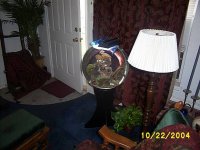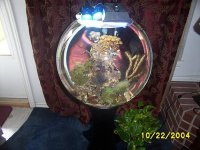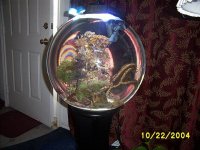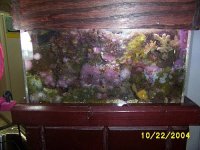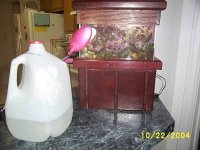I'd like to discuss in this thread some of the interesting dynamics associated with keeping nano reefs in odd-shaped containers. One might choose odd containers due to accessibility, price, appeal, or to try something new but the end result (if worked successfully) is always an increased understanding of nano-reef dynamics and more stable subsequent setups. This sort of experimentation builds confidence in the nano reef aquarist, removes the mystery out of nano reef abilities, and can be conducted in a responsible manner using aquacultured items that may be of signficant cost but bear no toll on non-renewable resources. The ethics associated with nano reef experimentation is a valid and completely different thread, so hopefully this focus is more directed to those who choose to take the leap for one reason or another.
Perhaps the best way to build a nano reef in an odd or small container is to fill the aquarium with water, a chosen circulation method (pump or air) live rock and sand (sand is optional) and allow the evaporation rates to become evident. I wouldn't choose especially-encrusted LR specimens for fear of initial dieoff, but a few chunks of established reef LR will get the system ready quickly for small corals frags after the balances have been established. Alter and record as many variables as you can predict; nanos and picos sometimes need to be fanned (for ex.) so try one and see how much the evaporation rate/oxygenation rate changes. You can experiment with lidded or open setups, assess topoff requirements and make changes that will directly alter the oxygenation and evaporation rates for a given pico or nano reef. Once the system can be predicted and balanced within tight clearances (i.e no more than a .003 salinity shift at any interval and +/- 3 deg Farenheit temp shift) for two weeks it can then be stocked with hardy coral frags and some motile inverts.
Pay particular attention to the neck or water/air interface of vase-type containers--hourglass shapes in this area have considerable effect on evaporation and oxygenation rates. Even allowing the water level to fluctuate up or down in certain shapes (not filling the water level to the exact same spot in the neck area each water change) changes the forecasted evaporation rate for a given time interval; simply put, you may memorize a 1.023 to 1.025 rise in specific gravity between a four day span set to one mark on the neck of the vase, but you drop that water line 1/2'' on the next water change and you now have a faster-evaporating water volume that will get you if you go the same four days without testing specific gravity! Divergent neck areas below the 'pinch' area of the hourglass shape in vase type bowls seem to impart logarithmic-type evaporation rates, apparently the water level evaporates and moves down it expanding the surface area at an increasing rate when compared to the 'pinch' area water line flux that maintains tighter control over the working surface area for a given time interval.
Reefbowl is actually a fitting name for the device featured below, based on design parameters, as goldfish bowl is also an accurate description of that kind of setup. How odd that a reef is actually able to run like a goldfish bowl...it turns out that limiting the fish bioloading relative to the water volume preserves the system chemistry plenty long enough to avoid being a water-change hassle (nitrate clearance) or an oxygenation issue.
--For starters, you can find an exact setup here www.naturesocean.com
About $189 for tank and stand IIRC> beware they are the most scratch-sequestering acrylic beasts on the planet, don't even breathe on them. Just hope your LR structure never tips over and lands on the side of the inner wall...
--I built a PVC support structure, a spire, out of 1/2 pipe some three-ways and 4 90's. Can diagram that if necessary. The end result is a middle pole sticking up two feet inside the sphere and all LR boulders are drilled through the middle and stacked on the support pole> guaranteed no shift! The end result is a tall reef structure jutting up with no side support--just a different way to layout an aquascape. The rest can be packed with LS or LR rubble to hide the existing support network. Some interesting features of this tank:
--Magnification is amazing. Around the equator of the tank a 3" coral-banded shrimp appears the size of your hand. Crisp detail is evident from all sides for the eye but not the camera.
--Juvenile ocellaris looks 5+ years old in the middle and 5 weeks old on the upper hemishpere!
--Cannot be photographed without terrible distortions--a major holdup to decent photography of this reef.
--evaporation rate appears to be on a log scale rather than linear; for example, when filled to top the shift is .003 every four-five days but when filled 80% full it's .003 every two and that's as far as I've tested it. Apparently the evaporating water line travels down the sphere, towards the bottom, and gains surface area for each incremental decline thereby evaporating (and oxygenating) faster. Early malpredictions here caused me to jack up the salinity up to .029 once while away and this killed some of my animals. hindsight...maybe it'll save some of you the headache.
--the website says its 16 gallon but is not--holds about nineteen or twenty before stocked.
--Tough to scrape for algae and diatoms--smallest shark magnet works well but only scrapes the outer edges which you have to clean every time because all algal accumulation builds up here. I recommend hand-cleaning it with a submerged papertowel.
--Not affected by windex, I spray it on there all the time. (no acrylic hazing)
--Currently I have a small CBS, three peppermints and a lysmata that all get along. Hope that doesn't change, they were at least all from the same display tank at the LFS> corals are frogspawn, torch and hammer along with xenia, palythoa and candy coral (caulastrea) and a Green star polyps (briareum) covered gorgonian. These are contradicting terms (GSP gorg)to those closely affiliated with taxonomy, but that's how it was marked in the LFS! I say this because true gorgonians and once-living-briareum-covered gorgonians aren't the same thing. May add SPS when the Coralife 150W HQI comes in...I am using three beautiful sabellid fanworms because it appears to me they eat cyclopeeze and may not be so hard to please. Accidental halving of a live fanworm during rearrangement once let out a cloud of previously-fed cyclopeeze which enticed me greatly--they are so colorful so I hope this may keep them alive better than previous attempts.
--red linkia star gets an underside full of cyclopeeze regularly--I can see him transporting it to the oral disk and ingesting it as he sticks to the side of the acrylic dome.
--Clownfish is accompanied by green clown goby-- two small fish in 18 gallons gives sufficent nitrate tolerance for the system in between bi-weekly changes.
--Not hard to heat and circulate-suction cupped powerhead and heater stick well to the upper back wall and are obscured by the curve.
--Circulation needs to transverse the system and not go round and round in it; I have observed that shooting the current along the curve of the globe creates tornadic activity in the setup where the perimeter of the current is violent and the exact center is rather still. Just aim the powerhead at the back of the rock and let it bounce off...
No matter what you choose for a substrate you won't be able to see much of it! The upper and lower 10% of the system is nearly 100% refracted out-of-sight, a tradeoff for reefing in a perfectly spherical aquarium. For that reason, I say go bare bottom and keep the detrital loading to a near zero. The raised PVC support system lets you stick a hose down into the lower region, keeping the bottom crystal clear of waste. pics:
Perhaps the best way to build a nano reef in an odd or small container is to fill the aquarium with water, a chosen circulation method (pump or air) live rock and sand (sand is optional) and allow the evaporation rates to become evident. I wouldn't choose especially-encrusted LR specimens for fear of initial dieoff, but a few chunks of established reef LR will get the system ready quickly for small corals frags after the balances have been established. Alter and record as many variables as you can predict; nanos and picos sometimes need to be fanned (for ex.) so try one and see how much the evaporation rate/oxygenation rate changes. You can experiment with lidded or open setups, assess topoff requirements and make changes that will directly alter the oxygenation and evaporation rates for a given pico or nano reef. Once the system can be predicted and balanced within tight clearances (i.e no more than a .003 salinity shift at any interval and +/- 3 deg Farenheit temp shift) for two weeks it can then be stocked with hardy coral frags and some motile inverts.
Pay particular attention to the neck or water/air interface of vase-type containers--hourglass shapes in this area have considerable effect on evaporation and oxygenation rates. Even allowing the water level to fluctuate up or down in certain shapes (not filling the water level to the exact same spot in the neck area each water change) changes the forecasted evaporation rate for a given time interval; simply put, you may memorize a 1.023 to 1.025 rise in specific gravity between a four day span set to one mark on the neck of the vase, but you drop that water line 1/2'' on the next water change and you now have a faster-evaporating water volume that will get you if you go the same four days without testing specific gravity! Divergent neck areas below the 'pinch' area of the hourglass shape in vase type bowls seem to impart logarithmic-type evaporation rates, apparently the water level evaporates and moves down it expanding the surface area at an increasing rate when compared to the 'pinch' area water line flux that maintains tighter control over the working surface area for a given time interval.
Reefbowl is actually a fitting name for the device featured below, based on design parameters, as goldfish bowl is also an accurate description of that kind of setup. How odd that a reef is actually able to run like a goldfish bowl...it turns out that limiting the fish bioloading relative to the water volume preserves the system chemistry plenty long enough to avoid being a water-change hassle (nitrate clearance) or an oxygenation issue.
--For starters, you can find an exact setup here www.naturesocean.com
About $189 for tank and stand IIRC> beware they are the most scratch-sequestering acrylic beasts on the planet, don't even breathe on them. Just hope your LR structure never tips over and lands on the side of the inner wall...
--I built a PVC support structure, a spire, out of 1/2 pipe some three-ways and 4 90's. Can diagram that if necessary. The end result is a middle pole sticking up two feet inside the sphere and all LR boulders are drilled through the middle and stacked on the support pole> guaranteed no shift! The end result is a tall reef structure jutting up with no side support--just a different way to layout an aquascape. The rest can be packed with LS or LR rubble to hide the existing support network. Some interesting features of this tank:
--Magnification is amazing. Around the equator of the tank a 3" coral-banded shrimp appears the size of your hand. Crisp detail is evident from all sides for the eye but not the camera.
--Juvenile ocellaris looks 5+ years old in the middle and 5 weeks old on the upper hemishpere!
--Cannot be photographed without terrible distortions--a major holdup to decent photography of this reef.
--evaporation rate appears to be on a log scale rather than linear; for example, when filled to top the shift is .003 every four-five days but when filled 80% full it's .003 every two and that's as far as I've tested it. Apparently the evaporating water line travels down the sphere, towards the bottom, and gains surface area for each incremental decline thereby evaporating (and oxygenating) faster. Early malpredictions here caused me to jack up the salinity up to .029 once while away and this killed some of my animals. hindsight...maybe it'll save some of you the headache.
--the website says its 16 gallon but is not--holds about nineteen or twenty before stocked.
--Tough to scrape for algae and diatoms--smallest shark magnet works well but only scrapes the outer edges which you have to clean every time because all algal accumulation builds up here. I recommend hand-cleaning it with a submerged papertowel.
--Not affected by windex, I spray it on there all the time. (no acrylic hazing)
--Currently I have a small CBS, three peppermints and a lysmata that all get along. Hope that doesn't change, they were at least all from the same display tank at the LFS> corals are frogspawn, torch and hammer along with xenia, palythoa and candy coral (caulastrea) and a Green star polyps (briareum) covered gorgonian. These are contradicting terms (GSP gorg)to those closely affiliated with taxonomy, but that's how it was marked in the LFS! I say this because true gorgonians and once-living-briareum-covered gorgonians aren't the same thing. May add SPS when the Coralife 150W HQI comes in...I am using three beautiful sabellid fanworms because it appears to me they eat cyclopeeze and may not be so hard to please. Accidental halving of a live fanworm during rearrangement once let out a cloud of previously-fed cyclopeeze which enticed me greatly--they are so colorful so I hope this may keep them alive better than previous attempts.
--red linkia star gets an underside full of cyclopeeze regularly--I can see him transporting it to the oral disk and ingesting it as he sticks to the side of the acrylic dome.
--Clownfish is accompanied by green clown goby-- two small fish in 18 gallons gives sufficent nitrate tolerance for the system in between bi-weekly changes.
--Not hard to heat and circulate-suction cupped powerhead and heater stick well to the upper back wall and are obscured by the curve.
--Circulation needs to transverse the system and not go round and round in it; I have observed that shooting the current along the curve of the globe creates tornadic activity in the setup where the perimeter of the current is violent and the exact center is rather still. Just aim the powerhead at the back of the rock and let it bounce off...
No matter what you choose for a substrate you won't be able to see much of it! The upper and lower 10% of the system is nearly 100% refracted out-of-sight, a tradeoff for reefing in a perfectly spherical aquarium. For that reason, I say go bare bottom and keep the detrital loading to a near zero. The raised PVC support system lets you stick a hose down into the lower region, keeping the bottom crystal clear of waste. pics:




